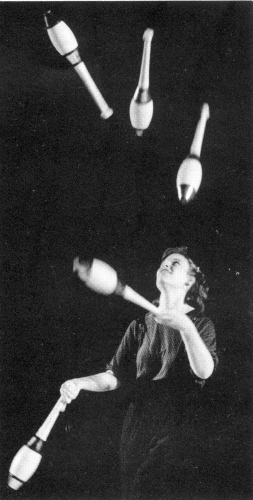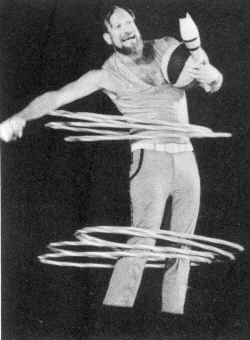
Cindy Marvell |

Larry Vaksman (Ginny Rose photo) |
Page 13 Fall 1989
|
Judges
Tackle Tough Job, Pick
First Female Champ
The
top three competitors in the IJA Individual Championships each
presented polished, professional acts -- but each presented juggling
in a totally different light.
How
did the five judges seated at the front of the auditorium decide
that Cindy Marvell's lively routine to Gershwin's music rated better
than Larry Vaksman's eccentric combination tricks, and that Vaksman
deserved to finish above Michael Mene's steely cold, smooth moves
with balls and rings?
The
choice of Marvell as the 1989IJA Individual Champion was not
unanimous, as this year's judges' scoresheets show. In an attempt to
make the process sturdier, championships director Craig Barnes
eliminated the points system of the past and asked judges to simply rate the seven final acts as one through seven. And while Marvell got three of five top votes, she also was picked as second by one judge and third by another. Vaksman
got two first place votes, a second and a fourth. Menes got two
second place votes, a third, a fourth and a fifth. The final outcome
was simply a compilation of scores, rather than a unanimous
decision.
The
scores also show that judges can interpret the same set of scoring
guidelines in different ways, arriving at their own subjective
decisions. Though the rules have been adjusted in minor ways during
the past few years, they have not changed substantially. Judges were
told to count technique as 60 percent of their score, and
performance as 40 percent. Hence, the difficulty of the juggling
tricks in the act, combined with how well they are executed, is
paramount.
"Performance"
is defined in the guidelines as stage presence and
characterization, routining and choreography, costume and music, and
artistry. WHEN
THEY WERE INTERVIEWED after the championships, the judges all said
their duty was extremely difficult because of the tremendous number
of variables in a juggling routine. Marvell' s routine ultimately
won because it combined difficult tricks with well-planned
choreography. While Vaksman's routine included combination tricks
that were probably more difficult than Marvell's, the act did not
have a strong "plot." Rather than a planned beginning,
middle and end, Vaksman simply presented trick after trick after
trick. Menes, on the other hand, presented a routine that was
minutely choreographed down to each glance and turn of the head, but
the judges felt the level of technical skill he displayed was not as
high as in the top two acts.
But technique and presentation can hardly be viewed separately, and therein the contention begins. One judge explained, "Menes did three balls and four and five rings. On the surface that doesn't seem to be difficult, but you combine it with his incredible movement skills and the fact that he's working so close to the music, and it becomes much more difficult. It's not easy though, unless you're familiar with that type of juggling, to know how difficult it is."
|

Cindy Marvell |

Larry Vaksman (Ginny Rose photo) |
|
Michael Menes |